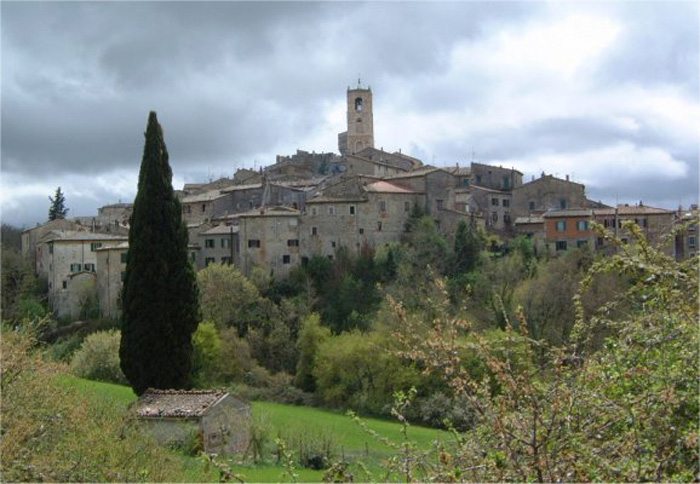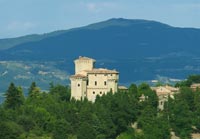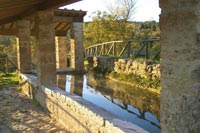 |
|
San Casciano dei Bagni
|
|
San Casciano dei Bagni |
| Val D’orcia and Val di Chiana enjoy a land rich in beneficial waters known since the beginning of time, that bubble for our benefit in beautiful and relaxing spas. San Casciano dei Bagni, ancient Tuscan country village nestles in the hills of Val D’Orcia, is an invigorating spa resort. Here you'll find the Bagno della Ficoncella, Bagno Grande, Bagno Bossolo and Doccia della Testa springs. San Casciano dei Bagni is located in Tuscany on the southern border of the province of Sienna. The main feature of this medieval town, which stands on the Sienese border between the regions of Umbria and Lazio, is its wealth of hot spring water. For the quantity of water it produces, this spa is the third largest in Europe. The history of San Casciano dei Bagni is strictly connected to the presence of these thermal springs. The 42 springs within its territory were discovered by the Etruscans and developed by the Romans. According to a legend, the Balnea Clusinae were founded by Porsenna, the Etruscan king of Chiusi. The baths were popular also during the Roman era, Augustus being amongst its users. The Thermal Baths of San Casciano dei Bagni reached their maximun development during the Medici's domination. The waters supplying the thermal baths of San Casciano dei Bagni gush from 42 springs. The therms are organized in four thermal baths: the Bagno della Ficoncella, the Bagno Grande, the Bagno Bossolo and the Doccia della Testa. The biggest thermal bath is the Bagno della Ficoncella, near which Ferdinando de Medici raised a porch to put into evidence his merits in the recovery of the thermal activity, the Portico della Ficoncella. There is a large complex offering various health and beauty treatments or bathe for free in the hot sulphurated waters of Bagno Bossolo and Bagno Grande. in the fourth-fifth century San Casciano already had a parish church called Santa Maria 'ad balneo'. During the Middle Ages the Pieve of St. Mary ad balneo was initially under Lombard rule, and later under the Visconti di Campiglia and the Abbey of San Salvatore. Collegiate of San Leonardo is the main church in St. Casciano. It was raised between the 12th and the 14th century as a parish church, but was anobject of radical transformations during the end of the 16th century and second half of the 18th century, when it assumed the form that it has today. The portal, made in gothic style, was discovered in 1948 on one of the lateral walls and subsequently put on the main façade. On the main altar there is a big pala, work of Pietro Di Francesco Orioli (Siena 1458-1496) representing the Coronation of Madonna. The Pagan Temple, which is probably the most ancient structure in San Casciano, is located next to the arcades of the spa. Not very far away from the town centre, you can admire Portico della Ficoncella porch, that today represents a precious decoration of Fonteverde Thermal Centre, and the church of Santa Maria della Colonna, the oldest monument in San Casciano dei Bagni, built on a small temple dedicated to Igea, the Goddess of health. The Chiesa Santa Maria della Colonna, standing in the heart of the countryside surrounding the spa area, dates back to the 4th and 5th centuries. Inside this church, there is a renaissance altar from the 16th century and many frescoes made by maestros of Siena and Orvieto schools. Traditional festivals include the Sagra dei Pici, a homemade pasta speciality in Celle sul Rigo, a village built on the site of a former fortress.
|
|
|
| Celle sul Rigo is a panoramic hilltop village in Southern Tuscany, 4 km from San Casciano, with great views over Mount Amiata, Radicofani and the rolling hills towards the Val d'Orcia. |
||
In the Middle Ages pilgrims converged on the spiritual home of European christianity from all over the continent, upon arrival in Italy following the route that linked Rome with Canterbury - the Via Francigena. The main routes leading to Italy have been rediscovered and are now used by pilgrims: one route is going to and coming from Santiago de Compostela. The other is the route used by pilgrims coming from the North of Europe through France and across the Great St. Bernard Pass and Aosta it goes to Vercelli as well. |
||
| The origin of Fighine is unknown; some people think there is a link between continua the name Fighine and the word “figuline” referring to some roofing tiles used by the Etrurians to cover their buildings that were probably made in the village. It is more likely that the development of the village was connected to the control and the defence of the Via Cassia that in Roman times passed through the valley below Fighine, across Palazzone, on the way between Chiusi and Orvieto. The Castello di Fighine, is a gem that shouldn't be missed. The castle rises in an exceptional strategical position, on the watershed between the valleys of the Paglia and the Chiana and from the castle, you can see right over the Val di Chiana as far as the distant peaks of the Umbrian Appennines. The castle still has its quadrangular original structure topped by tree towers and it houses the Church of St. Michael the Archangel on the inside. It is a building with a rectangular plan and characterized by a medieval architecture,The S.Michele Archangel Church has the apse turned to east, according to the ancient tradition, rectangular plant, wooden roof, brickwork paving and two little lateral chapels. In origin it had five altars, today only three. Inside the church, some paintings of the Orvieto and Florence art schools can be admired. Behind the greater altar catch the eye the one of S.Michele Archangel, painted by Bonichi of Lucignano in 1750. |
 Castello di Fighine |
|
The origin of Palazzone, the other small village near San Casciano, is likely due to its position on one secondary branch continua of the Roman Via Cassia on the way between Orvieto and Chiusi, and it was like a trading centre for the overlooking castle of Fighine.
|
Festival of the Ciaffagnone The Festival of the Ciaffagnone is celebrated every year at the beginning of June in San Casciano, a short walk from the centre of the hamlet. |
|
|

